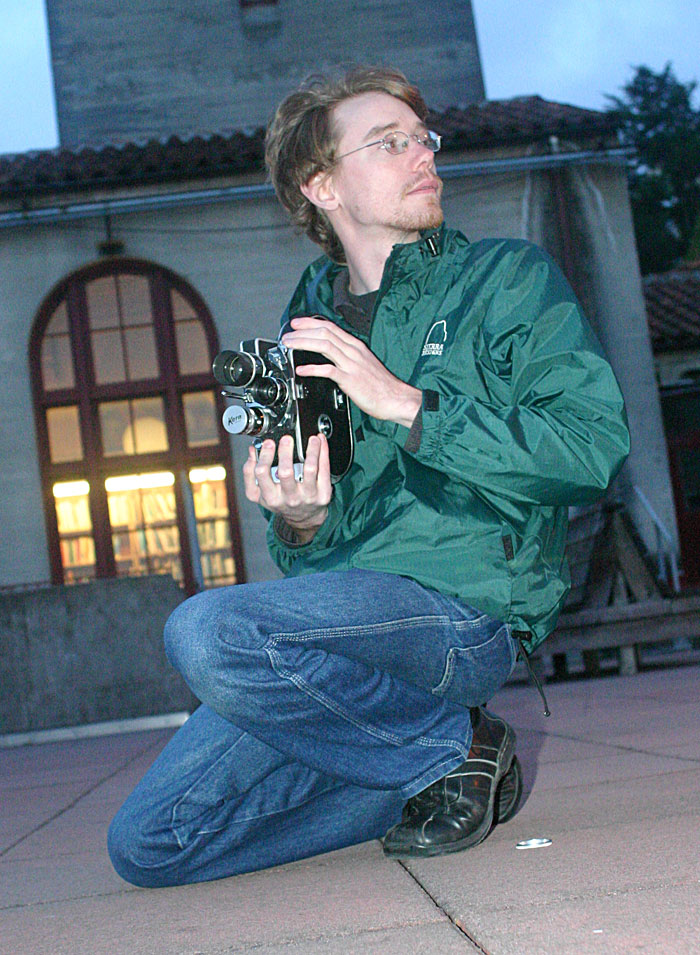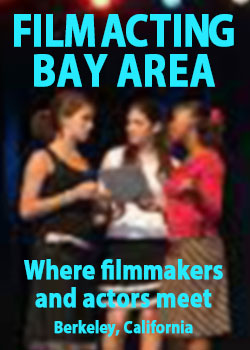Film Fades at SFAI
by Doniphan Blair
 Jeremy Menzies, a student leader trying to save SFAI from itself, makes his films old school. photo: CineSource
Jeremy Menzies, a student leader trying to save SFAI from itself, makes his films old school. photo: CineSource
Add to this a new high-profile administration composed of academics from back East and Europe (as well as one of the aforementioned commercial art schools), and their decision to lay off teachers in apparent disregard for the institute's solid art tradition - it was founded in 1871 by artists and writers with a unique view of how to create culture in the West - and you've got a sad state of affairs.
On February 17, the administration announced the layoffs of nine tenured teachers (about 25% of SFAI's faculty) including three from the film department, halving its tenured faculty. Although they met with students to address grievances, President Chris Bratton, formally of the Chicago Art Institute, largely evaded relevant issues and not long after announced a new School of Design, generally considered an anathema at the institute. By March, not just students were protesting.
Steve Anker, current CalArts Dean of Film/Video and former SFAI filmmaking faculty-member, issued an appeal on behalf of his former colleagues. Some - like Robert Johnson and Pat Klein - had been at the institute over 25 years; Janis Crystal Lipzin was there for 31 years. The head of the film department, Lipzin was the last faculty member to teach hand processing, which many students cherished and which serves as an obvious symbol both of film's tactile quality, as opposed to digital media, and the institute's values.
"We have lost people the students wanted at the school. The new administration didn't see them fitting into their vision," Jeremy Menzies told me. He just finished his BFA in film in December, and inadvertently became one of the leaders of the protest, putting up posters, organizing meetings and attending board meetings to present the student's side.
Anker feels the layoffs are "an indication of the final phase-out of the avant-garde and poetic tradition in SFAI's curriculum," the very reason students like Menzies choose to attend SFAI. "It seemed more serious than other schools," said Menzies, who checked out various West Coast art schools and was accepted at the Academy of Art University, which he derided as a "trade school."
According to Anker, these professors will be replaced by part-time teachers who are paid less and denied benefits. Although budget cuts were cited, Anker, Menzies and others suspect that another reason is that three of the nine faculty being laid off are current or former representatives of the faculty union. Indeed, one was suspended from teaching last year after a public conflict with the administration. Moreover, Anker claims the administration had retained a law firm known for its union-busting.
The move was apparently spearheaded by Dean Okwui Enwezor, who took over in 2005. An internationally-known curator and writer from Nigeria, Enwezor, 46, is a fascinating figure in his own right. After moving to New Jersey in 1983 to study political science at the Jersey City State, he went on to become a reknowned visiting professor in art history, teaching at Columbia University and the University of Umea, Sweden, curating world-class shows at the International Center of Photography and the Guggenheim and serving as artistic director of big festivals, like the Bienal Internacional in Seville, Spain, and Documenta 11 in Kassel, Germany. But prior to being Dean of SFAI, Enwezor had little academic experience.
"I think he's a bad fit for the art institute," said Menzies. "He is not invested in the students and he was rarely on campus. He was hired as a figurehead. I have talked to international film students who would name names like [Larry] Jordan, [George] Kuchar and [Ernie] Gehr [well-known SFAI filmmakers, see CineSource's CineClips for samples] but when they arrived a lot of that legacy has been reduced." (Kuchar still teaches.) "The new professors that are being hired are generally focused on documentary and narrative approaches and do not have as much experience working with physical film." Although this is fine, many students attend SFAI because of its long experimental tradition. "There can be a balance between these two modes of practice," Menzies concludes "one that is healthy for all and that brings a vibrancy to SFAI."
"Many of the faculty think the layoffs of tenured faculty is simply terrible but others don't and are just happy they are not the ones laid off," noted one of the latter group's number, who preferred not to be named, in an email. "There are two sides to all tales," the person continued. "SFAI is, indeed, in a terrible financial situation and has been for quite some time. We ought to take a 25% pay cut in order to continue to work and provide good studio practice and make art."
President Bratton claims he and other top administrators did just that: they took a 25 percent pay cut last year. "I challenge you to find another institution where senior staff has taken such a deep pay cut," Bratton said, according to Joe Eskenazi in the April 3rd SF Weekly blog. Not only is SFAI in a desperate financial straights, "I can tell you that everything we've done has been entirely within the letter of our contracts and state and federal law. There's no easy way to make these sorts of reductions."
In fact, educators across the country are being driven to retool. A recent New York Times Op-Ed piece by Mark C. Taylor (4/27/09) says: "If American higher education is to thrive in the 21st century [they] must be rigorously regulated and completely restructured... The division-of-labor model is obsolete and must be replaced with a curriculum structured like a web or complex adaptive network."
Perhaps this is what Bratton and Enwezor are attempting: as in the planned school of design, to open in 2010. "I have no bias against design but we already have a design and tech department," said Menzies. "I feel it is extravagant and the only purpose is to draw more students and revenue. Having an entire school of design will squeeze other departments."
Although the school has been good about keeping financial aid a priority, important since tuition is now a staggering $31,000 per annum. Despite the rise, a lot of services have been lost. The photo dept sold off an analog photo printer valued by students. Two friendly maintenance men, who would help students install work, quit when the school cut their hours. Rather then investing in what the school already has that is of value, the administration is pushing for something different.
"SFAI has a unique place in the market for people who don't want to go a trade school," says Menzies. "It has held on to being avant-garde since 1871. You make art because you need to, not because you can get shows or make a name. The people who are teaching art at SFAI are artists and excellent educators because they have passion. People are still drawn here because of that. The Dean and President want our school to be highbrow and image-conscious. I think a lot of their motivation is to develop it as a revenue producing institution. That has become very apparent in their recent rhetoric about what they are planning - school as a corporation rather than place for artists to come together and share ideas and create something that is not tied to money."
"I went to a board meeting and they said we need to find our brand. And as much I hate to think about that, I think it is already there: the brand is the spirit of the place; the spirit of making art."
The commercial art schools have already attracted thousands of art students from Japan and elsewhere, some of whom are too edgy for those schools. If the Art Institute marketed itself as what it is, a beautiful campus with free-thinking teachers, where one can make and study art, in the egalitarian doing rather than thinking too much style of the West, it would win more paying students in the free market place of ideas and become solvent both financially and artistically. Posted on Sep 22, 2010 - 12:12 AM
by Doniphan Blair
 Jeremy Menzies, a student leader trying to save SFAI from itself, makes his films old school. photo: CineSource
Jeremy Menzies, a student leader trying to save SFAI from itself, makes his films old school. photo: CineSourceAdd to this a new high-profile administration composed of academics from back East and Europe (as well as one of the aforementioned commercial art schools), and their decision to lay off teachers in apparent disregard for the institute's solid art tradition - it was founded in 1871 by artists and writers with a unique view of how to create culture in the West - and you've got a sad state of affairs.
On February 17, the administration announced the layoffs of nine tenured teachers (about 25% of SFAI's faculty) including three from the film department, halving its tenured faculty. Although they met with students to address grievances, President Chris Bratton, formally of the Chicago Art Institute, largely evaded relevant issues and not long after announced a new School of Design, generally considered an anathema at the institute. By March, not just students were protesting.
Steve Anker, current CalArts Dean of Film/Video and former SFAI filmmaking faculty-member, issued an appeal on behalf of his former colleagues. Some - like Robert Johnson and Pat Klein - had been at the institute over 25 years; Janis Crystal Lipzin was there for 31 years. The head of the film department, Lipzin was the last faculty member to teach hand processing, which many students cherished and which serves as an obvious symbol both of film's tactile quality, as opposed to digital media, and the institute's values.
"We have lost people the students wanted at the school. The new administration didn't see them fitting into their vision," Jeremy Menzies told me. He just finished his BFA in film in December, and inadvertently became one of the leaders of the protest, putting up posters, organizing meetings and attending board meetings to present the student's side.
Anker feels the layoffs are "an indication of the final phase-out of the avant-garde and poetic tradition in SFAI's curriculum," the very reason students like Menzies choose to attend SFAI. "It seemed more serious than other schools," said Menzies, who checked out various West Coast art schools and was accepted at the Academy of Art University, which he derided as a "trade school."
According to Anker, these professors will be replaced by part-time teachers who are paid less and denied benefits. Although budget cuts were cited, Anker, Menzies and others suspect that another reason is that three of the nine faculty being laid off are current or former representatives of the faculty union. Indeed, one was suspended from teaching last year after a public conflict with the administration. Moreover, Anker claims the administration had retained a law firm known for its union-busting.
The move was apparently spearheaded by Dean Okwui Enwezor, who took over in 2005. An internationally-known curator and writer from Nigeria, Enwezor, 46, is a fascinating figure in his own right. After moving to New Jersey in 1983 to study political science at the Jersey City State, he went on to become a reknowned visiting professor in art history, teaching at Columbia University and the University of Umea, Sweden, curating world-class shows at the International Center of Photography and the Guggenheim and serving as artistic director of big festivals, like the Bienal Internacional in Seville, Spain, and Documenta 11 in Kassel, Germany. But prior to being Dean of SFAI, Enwezor had little academic experience.
"I think he's a bad fit for the art institute," said Menzies. "He is not invested in the students and he was rarely on campus. He was hired as a figurehead. I have talked to international film students who would name names like [Larry] Jordan, [George] Kuchar and [Ernie] Gehr [well-known SFAI filmmakers, see CineSource's CineClips for samples] but when they arrived a lot of that legacy has been reduced." (Kuchar still teaches.) "The new professors that are being hired are generally focused on documentary and narrative approaches and do not have as much experience working with physical film." Although this is fine, many students attend SFAI because of its long experimental tradition. "There can be a balance between these two modes of practice," Menzies concludes "one that is healthy for all and that brings a vibrancy to SFAI."
"Many of the faculty think the layoffs of tenured faculty is simply terrible but others don't and are just happy they are not the ones laid off," noted one of the latter group's number, who preferred not to be named, in an email. "There are two sides to all tales," the person continued. "SFAI is, indeed, in a terrible financial situation and has been for quite some time. We ought to take a 25% pay cut in order to continue to work and provide good studio practice and make art."
President Bratton claims he and other top administrators did just that: they took a 25 percent pay cut last year. "I challenge you to find another institution where senior staff has taken such a deep pay cut," Bratton said, according to Joe Eskenazi in the April 3rd SF Weekly blog. Not only is SFAI in a desperate financial straights, "I can tell you that everything we've done has been entirely within the letter of our contracts and state and federal law. There's no easy way to make these sorts of reductions."
In fact, educators across the country are being driven to retool. A recent New York Times Op-Ed piece by Mark C. Taylor (4/27/09) says: "If American higher education is to thrive in the 21st century [they] must be rigorously regulated and completely restructured... The division-of-labor model is obsolete and must be replaced with a curriculum structured like a web or complex adaptive network."
Perhaps this is what Bratton and Enwezor are attempting: as in the planned school of design, to open in 2010. "I have no bias against design but we already have a design and tech department," said Menzies. "I feel it is extravagant and the only purpose is to draw more students and revenue. Having an entire school of design will squeeze other departments."
Although the school has been good about keeping financial aid a priority, important since tuition is now a staggering $31,000 per annum. Despite the rise, a lot of services have been lost. The photo dept sold off an analog photo printer valued by students. Two friendly maintenance men, who would help students install work, quit when the school cut their hours. Rather then investing in what the school already has that is of value, the administration is pushing for something different.
"SFAI has a unique place in the market for people who don't want to go a trade school," says Menzies. "It has held on to being avant-garde since 1871. You make art because you need to, not because you can get shows or make a name. The people who are teaching art at SFAI are artists and excellent educators because they have passion. People are still drawn here because of that. The Dean and President want our school to be highbrow and image-conscious. I think a lot of their motivation is to develop it as a revenue producing institution. That has become very apparent in their recent rhetoric about what they are planning - school as a corporation rather than place for artists to come together and share ideas and create something that is not tied to money."
"I went to a board meeting and they said we need to find our brand. And as much I hate to think about that, I think it is already there: the brand is the spirit of the place; the spirit of making art."
The commercial art schools have already attracted thousands of art students from Japan and elsewhere, some of whom are too edgy for those schools. If the Art Institute marketed itself as what it is, a beautiful campus with free-thinking teachers, where one can make and study art, in the egalitarian doing rather than thinking too much style of the West, it would win more paying students in the free market place of ideas and become solvent both financially and artistically. Posted on Sep 22, 2010 - 12:12 AM























